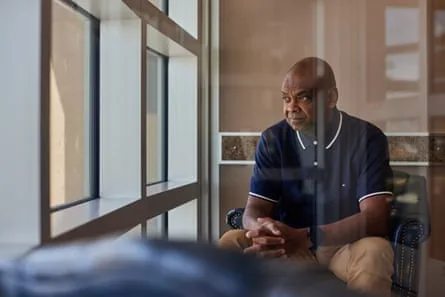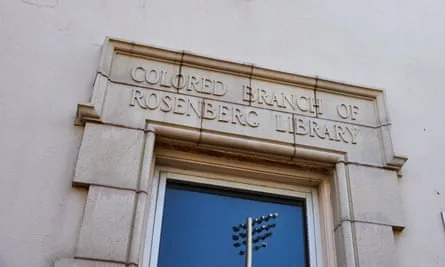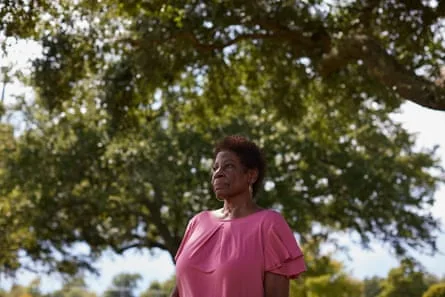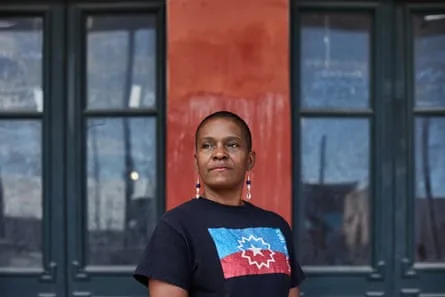The square in front of the county courthouse on Galveston Island, a barrier island on the Gulf coast of Texas, is dominated by a 40ft statue titled Dignified Resignation that depicts a Confederate soldier coming home at the end of the civil war. He stands tall and defiant, and at his feet is a scroll that reads: “Glory in defeat.”
The statue, erected in 1911 by the United Daughters of the Confederacy, is especially toxic given its location. Galveston Island was the busiest slave port in antebellum Texas, trafficking more than 11,000 enslaved people; it is also the birthplace of Juneteenth, the official US holiday that celebrates the final end of US slavery.
In the wake of George Floyd’s murder in 2020, protesters demanded the removal of the statue as an icon of white supremacy. Galveston county debated the issue and took it to vote. Three of the four commissioners who sit on the commissioners court, joined by the county judge – all of whom were white and Republican – voted to keep the statue in place. Only one commissioner, the representative of Precinct 3 who is African American and Democratic, opted for removal.
The lone commissioner, Stephen Holmes, was outvoted and the statue remains in situ to this day. But his presence ensured that progressive arguments for addressing a cultural icon offensive to many were at least put on the record.
“A Confederate statue should not sit in a place of honor in our courthouse square,” Holmes told the Guardian.

A 10-minute walk away from the statue of Dignified Resignation, a legal battle is unfolding in federal court that will determine whether Holmes’s voice is in effect silenced. The suit went to a 10-day trial culminating last week with closing arguments.
The legal action is the first of its kind after a supreme court ruling in June affirmed federal protections enshrined by the 1965 Voting Rights Act, the crowning achievement of the civil rights movement, against racial discrimination in voting laws. It is being closely watched nationally as a vital test case.
At stake is whether Black and other minority voters can continue to rely on the Voting Rights Act amid a rash of Republican racial gerrymandering sweeping the country. Has the legislation already been eroded beyond usefulness?
The lawsuit challenges new electoral maps that have been introduced by the Republicans who control Galveston county – the three Republican commissioners and a fellow Republican county judge. Tied to the 2020 census, their new maps reshape Holmes’s majority-minority district out of existence.
Under their redistricting plan, the district turns from having 58% of voters who are African American and Latino, into a majority-white entity with only 28% Black and Latino voters. Galveston county would lose its lone district, known as Precinct 3, which for more than three decades has given minority voters, who overwhelmingly lean Democratic, the ability to elect a representative of their choice.
Lucille McGaskey, a longtime resident who was involved in the push to create Precinct 3 as a crucible of Black political power and who testified at the redistricting trial, said that people had struggled hard “so that we would have a seat at the table. We lose Precinct 3, we lose that seat – we lose our identity.”
The federal court case is local in essence – it involves just 350,000 residents of Galveston county. Unusually, though, it has drawn the national spotlight.
The Department of Justice has joined local African American and Hispanic plaintiffs to sue the county Republicans. They are collectively seeking to block the plan to eviscerate Precinct 3 as a majority-minority district by invoking section 2 of the Voting Rights Act, which prohibits intentional discrimination in voting laws and procedures on the basis of race or color.
They argued in court that the new maps were a textbook example of “cracking”. That’s the technique often used in racial gerrymandering in which minority voters are split up and parceled out evenly among multiple districts, depriving them of a majority stake in any one.
Supporting the Republicans are several leading conservative groups that promote measures to make voting more difficult, including the Public Interest Legal Foundation. They argued that the new maps were race-neutral and motivated by politics rather than race.
The trial is the first to be conducted since the US supreme court, in a surprise ruling delivered by Chief Justice John Roberts last June, upheld section 2 as a last bastion against racially discriminatory election practices. The ruling, Allen v Milligan, has prompted a display of extraordinary resistance from Republican lawmakers in Alabama who were on the losing side.




Last week they were slapped down for a second time by a federal court on grounds that their new electoral maps weakened the power of the Black vote by giving African American Alabamans, who make up almost a third of the electorate, only one of seven congressional seats. The Republicans have responded defiantly by petitioning the supreme court – yet again.
The aggressive refusal of Alabama to abide by constitutional law enshrined in the Voting Rights Act is part of a nationwide pattern of controversial redistricting by Republican-controlled states. Georgia, Louisiana, Ohio and others have all pushed the legal limits of racial gerrymandering.
The Campaign Legal Center’s Valencia Richardson, an attorney representing some of the Galveston county plaintiffs, said that the legal battle playing out in Texas would have ramifications for the struggle elsewhere. “This is a microcosm of what we are seeing across the country. Efforts are spreading to eliminate opportunity for Black and brown voters to elect their candidates of choice.”
She added: “This is a hyperlocal case in a single county in Texas. But its implications for American representation and democracy are great because local government affects people’s daily lives more than anything else.”
For Holmes, this fight is personal. He has represented Precinct 3 as the sole Black and Democratic county commissioner since 1999.
Under the new maps, there is next to no chance of him being re-elected. Like much of the south, voting patterns in Galveston county are starkly polarized by race. More than 85% of voters of color prefer Democratic candidates, while a similar proportion of Anglos, as whites are known in Texas, back Republicans.




But the commissioner insists that this moment is not about him. “It’s really about the community and what they stand to lose,” he said, talking to the Guardian in his office in Texas City, decorated with a portrait of Rosa Parks and a framed front page from 2008 headlined: “Obama Makes History.”
In his 24 years as a commissioner, Holmes has earned the trust of voters in Precinct 3, winning re-election six times. A large part of his popularity, as demonstrated by the vote over the Dignified Resignation statue, is that he provides a counterpoint to the white Republicans who control the county.
While they press for cuts in public services and taxes, he argues for more resources for schools, more support in renovating run-down homes, more help with healthcare, job searches and poverty relief. That’s important in a county in which the mean per-capita income of Anglos is $45,465 but only $26,006 for Black residents and $25,091 for Latinos.
At the height of the pandemic, Galveston county’s Republican commissioners came up with a plan to send close to $6m of taxpayers’ money to the border with Mexico to help build Donald Trump’s wall. Holmes was the only commissioner to oppose the idea. “The border is 350 miles away from us, why would we be sending our money down to the border?” he said.
Edna Courville, 79, a social worker who is one of the plaintiffs in the federal lawsuit, said that Holmes was attentive to the daily needs of the community in ways that might seem small but which made lives safer and more rewarding – like adding sidewalks to busy roads where children can walk home from school.




She also expressed her pride in her local Carver Park, one of the first African American parks to be created in Texas. Its 23 acres, lined with majestic southern live oaks, sit at the heart of the 1867 Settlement, a community of formerly enslaved people created after the civil war.
“The new maps, they practically make the park and the community around it non-existent,” Courville said. “They split them up three or four ways.”
The Rev William Randall, 66, of Greater St Matthews Baptist church in Hitchcock, who is prominent among Galveston county’s powerful network of Black pastors, also invokes Carver Park as he explains what minority representation and Precinct 3 mean to him. As a child, he said, he played Little League baseball there, and grew up thinking that it was normal to have to improvise with broken bats, worn balls, rickety bleachers and bald and lumpy fields.
Then one day he went to the white neighborhood, where he was usually careful not to go, this being the era of Jim Crow segregation. He was amazed by what he saw: a park where the grass was lush and evenly cut, the baseball equipment pristine.
“I just thought that’s the way it is, you know,” he said. “It was nice over here, it wasn’t nice on my side.”
The arrival of Wayne Johnson, Holmes’s predecessor as the first African American commissioner for Precinct 3 in 1988, changed that. Johnson made it a priority to upgrade Carver Park, reseeding the ball field and replacing the bats and balls, introducing a basketball court and then a swimming pool.
As the park was transformed, so was Randall’s spirit. “It changed me. It showed me it didn’t have to be this way. It showed me that we could strive for a better life.”




Holmes told the Guardian that he “knew that the fix was in” with Galveston county’s redistricting as soon as he heard that his fellow Republican commissioners had contracted Dale Oldham to advise them. Oldham is a renowned conservative mapmaker who worked closely with the late Thomas Hofeller, described as the “master of the modern gerrymander”.
Holmes closely watched Oldham at work during the last round of redistricting in 2011. That year the federal government blocked Republicans from diluting minority representation in Precinct 3 and other elected positions in the county.
At that time Section 5 of the Voting Rights Act prevented changes to voting laws without advance approval from the Department of Justice. That safeguard, known as preclearance, was abolished by the conservative justices on the US supreme court in 2013 in Shelby county v Holder.
That absence has left Galveston’s minority voters cruelly exposed. Less than two months after Shelby, Galveston Republicans moved to push back minority representation among justices of the peace and constables in the county.
Now, for the first time in almost 50 years, they have been able to redraw electoral districts for the commissioners without prior federal oversight. Sure enough, the maps that emerged with Oldham’s help confirmed Holmes’s worst fears: Precinct 3 was cracked beyond recognition.
Holmes was dismissive about the Republican defendants’ closing argument that the new maps were motivated by political rather than racial concerns. “These guys are experts, they know that voting is racially polarized in Galveston county. You say Republican or Democrat, that’s just a proxy for racial identification.”
Galveston county, and the nation, now wait on tenterhooks for a ruling to come from the federal court on the island. The presiding federal judge, Jeffrey Brown, was appointed by Trump and has issued some highly contentious rulings including blocking Joe Biden’s Covid mandate that all federal workers receive vaccination.
Residents of Precinct 3 have been contemplating what will happen should they lose the case, and with it their political representation. “We could go back to the 40s and 50s – not even the 60s,” said Wendy Langham, 67, a community activist in Texas City.
Roxy Hall Williamson, 54, a community advocate born and living on Galveston Island, fears that it could demoralise Black and Latino voters. Why bother to vote when you are outnumbered?
“It’s already very difficult to get people to participate,” she said. “Losing our precinct would definitely deter folks from running for office.”




Randall painted an even bleaker picture of the future should the court challenge fail. “If we lose Precinct 3 we will get ignored, pushed to the side, and some of us will probably feel, ‘What’s the use? We put up a good fight, and we lose anyway.’”
The pastor paused for a while, then resumed. “We would just have to find another way,” he said. “No one’s going to stop us. Look at the history of our people, we always come back. We may seem down, but we’re not out. In the end, right will always win.”


